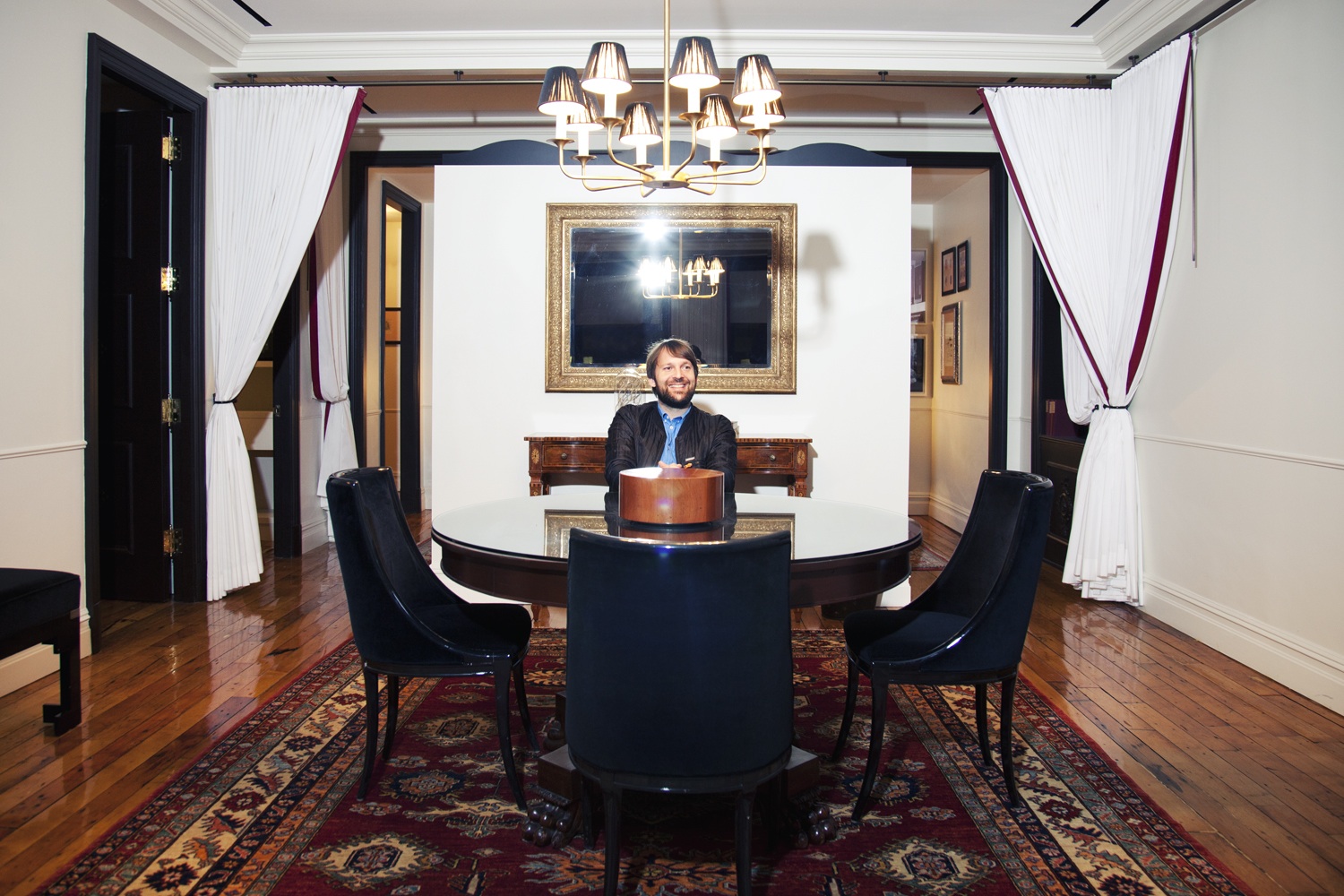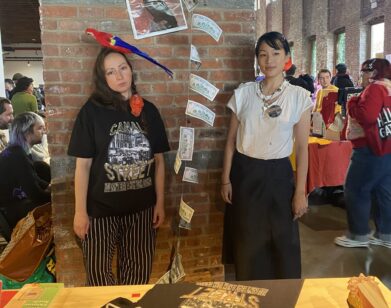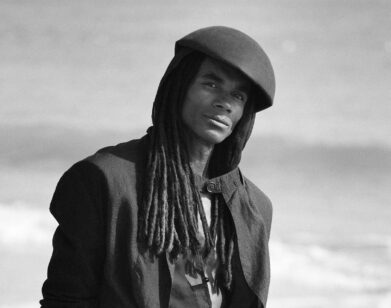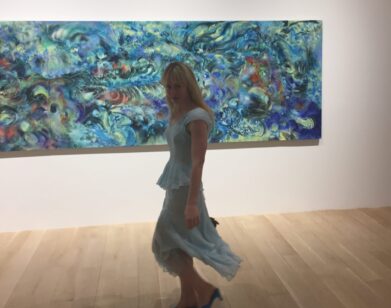René Redzepi’s Foraging Fundamentals

PORTRAIT OF RENE REDZEPI, ABOVE, TAKEN BY KATE OWEN AT THE SUITE ROYAL AT THE NOMAD HOTEL, NEW YORK CITY
When chef René Redzepi strides into the dimly lit library at the luxury Nomad hotel, he feels a bit thrown. “So dark!” he exclaims, gesturing at the drawn shades between crowded chestnut bookshelves, a bleak contrast to the delicate paleness that saturates Copenhagen, his home. “The Danish would not stand for this.” Redzepi had landed in New York hours ago, the first stop of a seven-city North American book tour promoting René Redzepi: A Work in Progress. It’s his second tour in three years, but he’s still very much getting used to international celebrity, and all the nice hotels, interviews, photo shoots, book signings, and general displays of pretension that come with it. He didn’t sign up for this when he decided to become a chef as a teenager, growing up between Denmark and Macedonia, his Muslim father’s native land. He is much more at ease, he’ll tell you, rummaging about the Danish landscape in search of ingredients for Noma, the three-time world’s best restaurant winner he opened in Copenhagen a decade ago.
After all, it’s his dedication to the art of foraging, balanced with an intense respect for seasonal food cycles, that’s gotten him here in the first place. When Redzepi founded the restaurant in a former warehouse space in 2004, culinary trends weighed heavily towards elaborate French and Mediterranean-style cooking. Traditional Scandinavian food, rooted in smoked and preserved dishes, was not so highly regarded. But, by chance, before Noma’s official opening Redzepi discovered a Swedish Army survival manual, which described in detail how to survive for a year off the land. “It blew my mind completely,” he remembers. Redzepi became hooked on the idea. From then on, Noma’s chefs would start their days exploring beach and forests, looking for ingredients to create new dishes, unique to any cuisine.
Still, when Noma won Restaurant magazine’s Best Restaurant in 2010, knocking the legendary Spanish restaurant El Bulli from the top spot, Redzepi was floored. “Nothing prepares you for it,” he says. Though ecstatic and honored, Redzepi felt a new sort of pressure as he and Noma were thrust into an international spotlight. He hadn’t dreamed of accolades for his restaurant, but suddenly they became his priority. Months later, when his wife asked him one night if he was okay, Redzepi realized he was not. So he took a four-week vacation to Mexico. Upon his return, he started a journal in hopes to understand why maintaining the restaurant had become so rough on him.
His entries, documenting and reflecting the Redzepi’s day in and day out for a year, are the core text of A Work in Progress, which also includes recipes and personal photos of Noma and its team. Through his descriptions of daily foraging, fluctuations of exhaustion and excitement, and mouthwatering soliloquies to dishes in the making, we’re allowed a glimpse at the relentless striving and passion of Redzepi and the people behind Noma.
After his eyes had adjusted to the library, we sat down with the chef to discuss his thoughts on food and life, which, to him, aren’t much different.
RACHEL SMALL: This is your second book with Phaidon. For this book, they’ve reprinted a year’s worth of your personal journal entries. How did you start keeping a journal?
RENÉ REDZEPI: It started in 2010 after we had won the world’s best restaurant for the first time, which was a pretty crazy thing that just happened. It’s overnight. Before that, Noma had always been run by a gut feeling–having fun and always playing around. You know, “Next year could be our last year.” So let’s make it a really intense, fun year where we worked for the content rather than being afraid of losing this potential good business.
SMALL: Yeah.
REDZEPI: The [first] book was out and for the first time we were on a book tour. Being the son of an immigrant, I’d never dreamt of being on book tours. Suddenly the attention was huge. I started to change. The decisions that were easy to make three months earlier, I was doubtful about. It was sort of a restaurant mid-life crisis, you could say. Everything was there: the villa, the Volvo, the dog, a marriage. You had reached that mountaintop. What should we do now? I found myself really liking the attention and also being very flattered about it. With enough time spent like that you also start, you know, changing. I lost a lot of confidence, not so much as a father or as a friend, but as a boss, as a chef that’s to make decisions throughout the day all the time. I was constantly in doubt of whether this was right for the restaurant or whether this was right for new accolades, you know? I just slowly started burning out. I could feel myself changing. Once you lose your confidence like that, you start being angry in the kitchen. You can’t handle it every time all these decisions and you don’t know which direction, and a new one comes, and a new one. At one point, you just start exploding. I couldn’t recognize myself anymore. And I told my wife, “Okay, we’re leaving. Now.” And my wife, she said, “You can’t leave. Everybody wants you. Are you crazy?” But I said, “If I don’t leave, I don’t know what’s going to happen.”
SMALL: So you took a one-month vacation to Mexico.
REDZEPI: Unfortunately, I can’t afford to take a month off. So I had to cook at a restaurant [in Mexico]. But that’s the situation for any restaurant, any chef that has a 40-seat restaurant. On the vacation, my goal was to understand, “Why are there bad days? Why are there good days? Why are you so afraid of doing what you feel like doing suddenly?” So I started writing the journal. It was never meant to be a book, but the editor at Phaidon read parts of it. As editors do, I guess.
SMALL: Did you have any reservations about letting people read it?
REDZEPI: No. I was just nervous that it was shit. That’s the only thing. We’re also in this crazy period. I mean, 21 years ago when I started cooking, to be a cook meant that you were going to stay in the basement. Being a chef, you would never be on a book tour. You could never dream that 20 years later on you would be on a book tour. It wasn’t a part of your dreams because it was just totally unrealistic. When did cooks—restaurant cooks, not cooks that have 15,000 television shows—when did cooks become part of pop culture the way they are?
SMALL: I feel like, throughout the entire journal, you can sense your stress. There was one bit where you described finding out you’d need 28,000 sloe berries every week to achieve a certain flavor. Your response was: “It was like a kidney punch.”
REDZEPI: That was also during winter. I can’t even begin to tell you how winter just can suck you in. It’s like it’s digging a black hole. It just puts you down there and it buries you. You’re there and you’re trying to dig your way out of winter. Suddenly you find this flavor and you need it now. It fits with this dish you’ve been testing, I believe it was, back then it was the endive dish. And suddenly, you’re like, no we can’t have it, you know. Such a big set back.
SMALL: Did you have trouble writing everyday?
REDZEPI: Yes. It’s like, “Come out! Get out!” And nothing comes out. You know, you wake up, your life is discipline: there’s kids, breakfast, lunch box, go to work, discipline, organization, guests. Imagine the semi-final of Super Bowl. We have that every day: lunch and dinner. We play that game.
SMALL: Twice. That’s intense.
REDZEPI: Then you come home and you really just want to drink a beer. But then you discipline yourself and you have to do this thing, this journal. It was painful but I’m so happy I did it. I have newfound respect for people that write.
SMALL: After a while, did your journal help you notice any patterns? Did you realize there were changes you wanted to make?
REDZEPI: One thing that I wanted to change—but I always knew that when I was writing the journal—was getting a more enjoyable workspace. Because in between all the pressures, the mise en place, the dead animals, the fish corpses, you name it. What binds it all together, all the elements, is actually fun. So I closed the banquet room, and I built a staff room. There’s music in the kitchen.
SMALL: There’s a long list of successful Noma chefs on your website. What do you teach the chefs that come into your kitchen?
REDZEPI: Well, there’s several things. Of course, technique. And then one thing that I think is extremely important, which is knowing your landscape, the curiosity to know that—the edible landscape around you, what’s there, what’s edible, what’s not edible. The full circle. I think that’s as important as technique.
SMALL: Also, obviously foraging is at the heart of your restaurant—what’s foraging 101? How would you only explain it to someone who’s only had prepackaged grocery store food their entire life?
REDZEPI: In a very basic sense, you’re connected to your place—that’s what foraging gives you. You understand what’s edible and you start seeing nature not just as a beautiful thing—as a picture-perfect thing to move in—but also as a very delicious resource. That’s a good thing. And I think that I have yet to meet anybody that starts foraging that doesn’t also feel they have a pact with it, which is also a great thing. Once you start actually indulging into it and really spending a lot of time in it you also want to take care of it much better. Basically you are obtaining a new skill set, a new knowledge, which connects you to the place that you’re in.
SMALL: I know when you first started out Noma, no one thought it was going to be this great.
REDZEPI: First of all, the traditional roots of Scandinavian cuisine are not that spectacular, to say the least. When we write about the traditions that we are inspired by, it’s more techniques like smoking, preserving. Many of them are not made to make food delicious; they’re just around so that you can make food last through the winter. There isn’t a great deal of tradition to tap into. In a sense, that’s a bad thing, but mostly it’s actually a very good thing because you can move freely. We don’t have 1,000 old recipes to choose from and update and nudge into a new way. At the same time, we don’t have a big tradition of eating everything that’s readily available. It was really starting from zero. What we found, of course, is that, with foraging, there was immediate connection—something that I never tried before. It also gives you a new palette of flavors that didn’t exist, either. In the book, I write about that moment where we taste what’s called beach coriander for the first time, which is an insane new thing. Beach coriander.
SMALL: That’s an amazing name.
REDZEPI: When we tasted it first we were, like, it tastes like coriander, it grows on the beach: beach coriander. We are very simple creatures in the kitchen. And then the technical word for it is sea arrow grass. And it looks like grass. It comes out of rock and seaweed, but it’s a succulent and when you snap it, it’s the sound of a watermelon—when you crack a watermelon.
SMALL: Do you think you’ve developed an instinct now about how to cook a new ingredient, at this point, that you discover?
REDZEPI: That’s the moment when everything starts. Before that, it was just setting up to that moment. We had spent six months on preparing the restaurant, finding staff, design and so on. And that’s 10 years ago almost. Now they’re building a bridge [linking mainland Copenhagen to the islet Noma is on].
SMALL: How do you feel about the bridge?
REDZEPI: Eh. Eh.
SMALL: Not good?
REDZEPI: Well, you know, our restaurant became a tourist attraction. People are there, they are taking pictures, buses are stopping. Sometimes you’ll be there and you’re explaining a dish, talking to some guest. They’re sitting as we are here and the window would be there and then you’ll have three Italian mothers looking in, calling friends over and pointing at the food. It’s just rude.
SMALL: That’s off-putting.
REDZEPI: But we’re going to solve it. We built a garden now, outside. You want natural light to come in, if you have natural light you never leave it out. You always allow it in. The natural light is very precious in Denmark.
SMALL: How do different ingredients inspire you?
REDZEPI: Going back in the journal, we could see this creative cycle through winter and spring. Spring is amazing. That’s New Year’s Eve to us, as cooks. Seriously.
SMALL: I believe it.
REDZEPI: You’re there and you’re ticking away these falling leaves and suddenly you see these, like, little, little tiny [makes a clicking sound] shoots of green popping up. That’s when you know life is about start again. There’s so much to handle, too much to handle. Summer’s the same, autumn is even more extreme. Then winter is when you sort of condense all of your ideas. You process all these things and you try to look for new concepts. In that sense, your intuition is in hibernation. What you fill up is your imagination; you fill up your memories there. That’s the challenge of winter. Somehow processing is everything that happens: you bring the best out of it into the next year. But when spring and summer happens, it’s intuition. Everything is based on intuition. There’s not too much time to overthink, over-complicate. Those wild strawberries, they might be there for two days.
SMALL: You gave a TED Talk in 2011. You mentioned “culinary common sense,” which I thought was a really interesting idea. Can you talk a little bit about what you mean by that?
REDZEPI: I just love this idea of using, especially in terms of food, using that common sense. If you follow that—it’s hard to talk about it without sounding like some New Age idiot, which I think is a bit unfair—but, if you do follow that natural cycle, you will inevitably eat better, cheaper, and much, much, much, much healthier. So culinary common sense boils down. Now that I have kids, I can even see that it makes even more sense.
SMALL: What thrills you most about cooking?
REDZEPI: Cooking, I mean, food, cooking foods is just everything that I do from morning to night. It’s how I choose to live my life: through cooking, people that are in food culture. And I love it. I love food. You see, in here [gestures around the room] everybody’s drinking, eating something. They’re joyful, they’re happy. That’s how they make sense of a meeting: they eat something. If they were in a sad moment it would be the same thing, they’d be eating something. It’s what makes life fun. We don’t need it to be delicious or great or all these things if we’re just to survive. But it’s one of those things that makes life fun, livable. And the more I submerge myself in it, the more fun I seem to have.
RENÉ REDZEPI: A WORK IN PROGRESS IS OUT NOW VIA PHAIDON. REDZEPI IS CURRENTLY ON A SEVEN-CITY BOOK TOUR AND WILL APPEAR TONIGHT, NOVEMBER 13, AT THE 92ND STREET Y IN CONVERSATION WITH PADMA LAKSHMI AND TOMORROW, NOVEMBER 14, AT SMITHSONIAN ASSOCIATES.






